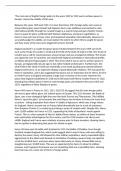‘The main aim of English foreign policy in the years 1509 to 1529 was to achieve peace in
Europe.’ Assess the validity of this view.
Between the years 1509 and 1529, it is clear that Henry VIII’s foreign policy aims were to
bring military glory upon himself and England. Henry was ambitious and wanted to raise
international profile through his curated image as a warrior king and gain chivalric honour.
Henry’s quest for glory conflicted with Wolsey’s diplomacy and peace negotiations, as
Henry’s main aim was to have a fear and respected reputation internationally. However, to
accurately judge the validity, we must explore the extent to which Henry sought for peace
and how many of the wars were triggered by Henry himself.
England assisted in a couple European peace treaties between the years 1509 and 1529,
such as the Treaty of London in 1518 and the Field of the Cloth of Gold in 1520. The Treaty of
London was a call for universal peace across Europe and was arranged by Wolsey. This treaty
was signed by over 20 countries and raised both England and Wolsey’s international profile,
as Wolsey became Papal Legate in 1518. This shows that it was an aim to achieve peace in
Europe, as England did not just sign it, but rather helped orchestrate it. Furthermore, the
1520 Field of the Cloth of Gold was essentially a two-week jousting tournament between
England and France, as an expensive display of good diplomatic relations. This was good for
Henry’s reputation, and it also suggested that peace was an important aim for Henry, for him
to invite Francis to England and spend a large sum of money on the event. However the
peace that England established in 1518 and 1520 lasted until Henry invaded France in 1522,
showing that military glory is Henry’s main foreign policy aim between the years 1509 and
1529, regardless of these displays of peace.
Henry VIII’s wars in France in 1512, 1513, 1522/23 all suggest that his main foreign policy
aim was to gain miliary glory, not achieve peace in Europe. This 1513 invasion, the Battle of
Spurs, was a non-strategical fight that won him both Tournai and Therouanne. This fulfilled
Henry’s ‘quest for glory’ as he became the only King to win territory in France for more than
a century – taking inspiration from Henry V’s battle of Agincourt, which was a large victory
for England. Henry’s second war on France failed dramatically due to a lack of assistance
from Emperor Charles V, so ended up just being a series of random raids. Despite this, Henry
sent 11,000 soldiers to France in 1523, supporting the Duke of Bourbon’s revolt against
Francis. This is a clear example of Henry’s battle-thirsty nature, as neither of these invasions
were particularly advantageous for the country, and the 1523 invasion cost Henry over
£400k. England and France were relatively at peace prior to these invasions, showing Henry
had no qualms in destroying that peace for almost no gain.
Henry VIII also went to battle with Scotland in 1513, the Battle of Flodden. Even though
Scotland invaded England first, which could suggest that it wasn’t Henry who was willing to
destroy the peace, Henry still showed his clear military aspirations. Henry responded highly
aggressively to the attack and showed no inclination of seeking a peace treaty. He opted to
crush the Scottish force, and even when James died early on, Henry showed little mercy,
slaughtering over 10,000 Scots. This was an opportunity for Henry to show his military
prowess, and it appears that peace was not something that was a possibility here, showing
how that was not a main aim of Henry’s foreign policy.




